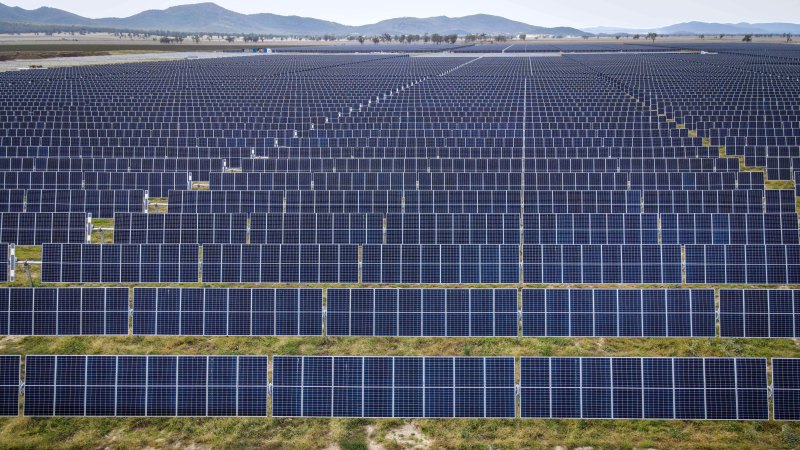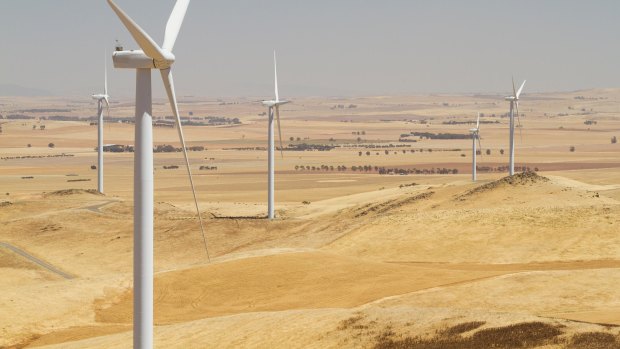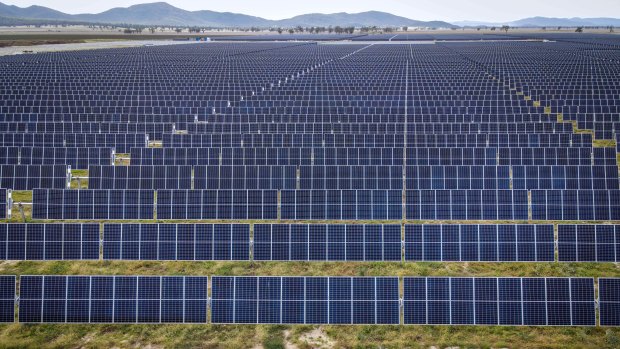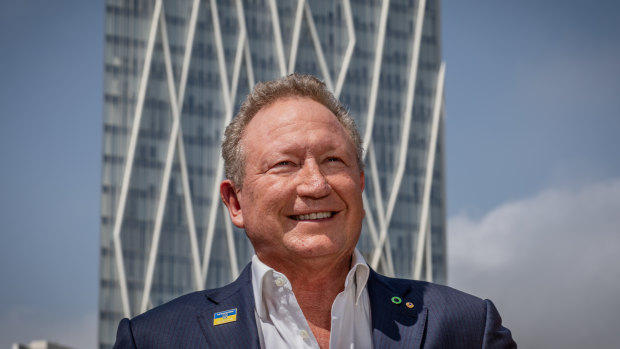Australia could be the Saudi Arabia of clean energy, powering the world
Australia is finally getting serious about global warming and everyone from oil giants to billionaire mining magnates are looking for a way to capitalise on the transformation.
Signs of change are everywhere. A new government has been elected, pledging to cut greenhouse-gas emissions faster; the biggest power grid has a multibillion-dollar plan to dump coal; and some of our richest people who made their fortunes in mining and technology are lining up huge green-energy projects designed to pivot the country from fossil-fuel king to a global supplier of green energy and the metals needed to build electric vehicles.
Renewable energy powerhouse: The Hallett Wind Farm in South Australia.
Few countries in the world can make such an outsize difference to climate change relative to their population. Australia’s addiction to coal and fossil fuels, both at home and for exports, has made it the largest carbon emitter per capita in the developed world. Yet by one estimate, the vast sunbaked country could generate 5000 exajoules of green energy— more than eight times current global demand. Even by more conservative assessments, Australia could power the world.
Photovoltaic modules at a solar farm on the outskirts of Gunnedah, New South Wales. Australia provides more than an opportunity to make a dent in global emission.Credit:Bloomberg
“We’re at a turning point,” said Will Symons, Melbourne-based Asia-Pacific climate and sustainability leader for Deloitte. “The challenge for us is to move at pace and move at scale, and that’s going to require new collaborations. Speed is everything.”
For companies including Elon Musk’s Tesla, oil giant BP and a host of Japanese conglomerates, Australia provides more than an opportunity to make a dent in global emissions.
As well as a potential source of green energy, it offers a unique platform to develop, test and build technologies thanks to its climate, minerals and ready-made infrastructure. That combination of resources is especially attractive for companies looking to produce green hydrogen, with funding and export deals pouring in from Germany, Singapore, South Korea, Japan and the UK.
‘We’re at a turning point. The challenge for us is to move at pace and move at scale, and that’s going to require new collaborations. Speed is everything.’
Still, the scale of the task is daunting. Australia’s economy has relied on digging out and selling its minerals — especially coal — for over a century. Last year, it mined about 400 million tonnes of the most-polluting fossil fuel. Yet in a symbol of how things are changing, the country’s largest power market this month reached a point where solar briefly overtook coal as the biggest source of electricity.
A big part of the shift is political. The federal election in May not only put Labor in power, it meant gains for the Greens party and several independent politicians who campaigned on environmental platforms. Prime Minister Anthony Albanese followed up his election promises by introducing a Climate Change Bill on July 27 aimed at cutting emissions 43 per cent by 2030 from 2005 levels.
“Australia’s open for business for renewable energy, for transmission, for storage, to create hundreds of thousands of jobs,” Climate Change and Energy Minister Chris Bowen told Sky News Australia.
In the media, a handful of our richest people have been grabbing headlines. Mike Cannon-Brookes and mining magnate Andrew Forrest are putting together $30 billion in funding to build a 4200-kilometre undersea cable to send solar power to Singapore that could begin construction in 2024.
Andrew Forrest is embracing renewable energy.Credit:Angel Garcia
“Twiggy” Forrest, founder of the country’s third-largest iron ore exporter Fortescue Metals, plans to make his entire fleet of trucks and trains in the Pilbara mining region carbon-free by 2040, according to regulatory filings. One of the billionaire’s biggest coups this year was to lure the Reserve Bank’s Guy Debelle, who had been tipped to become the next governor of Australia’s central bank, to work for him.
“We haven’t got all the time in the world, we need to be doing something now,” said Debelle, now chief financial officer of Forrest’s clean-energy venture, Fortescue Future Industries, which also plans to start producing 15 million tonnes a year of green hydrogen by 2030.
The billionaires aren’t the only ones in the country turning green. Oil major BP linked up with green hydrogen firm InterContinental Energy and solar supplier CWP Global to lead what could become one of the world’s biggest clean energy projects — a 26-gigawatt solar and wind farm in Western Australia. The project would pump out 1.6 million tonnes of hydrogen, or 9 million tonnes of ammonia a year.
Meanwhile, Japan received its first shipment this year of Australian carbon-neutral hydrogen made from brown coal on the Suiso Frontier, a purpose-built hydrogen tanker made by Kawasaki Heavy Industries.
“We can be the equivalent of Saudi Arabia in clean energy,” said Murray Shearer, chair and professor of hydrogen and alternative energy at CQ University in Gladstone. “We have all the natural advantages, and we need to grab these things before they go somewhere else.”
Australians have more reason than most to worry about global warming and rising sea levels. While Londoners in the UK sweltered through an unusually hot July, Onslow in Western Australia had the mercury rise to 50.7 degrees in January, the highest temperature recorded on the continent. Even in the western suburbs of Sydney, summer temperatures regularly melt asphalt. The “black summer” of 2019 and early 2020 had the country’s worst bushfires in living memory.
And while the dry, inhospitable interior of the country may be good for mining and solar farms, it means that nine out of 10 Australians live near the coast – mostly along the eastern coast, which was battered by deadly floods this year.
The continent has “absolutely extraordinary potential that’s only just beginning to be realised on the renewable side,” Mark Carney, former governor of the Bank of England and now head of Brookfield Asset Management’s Global Transition Fund, told a Melbourne conference via videolink on July 28. “Seizing that will create more jobs and more opportunity.”
‘Extraordinary potential’
Yet for Australia to capitalise on its clean-energy potential and create enough jobs to replace those lost from the demise of dirty fuel, the nation needs to develop a much wider green ecosystem than it has, one that includes research, start-ups, skills and especially funding. A Deloitte index of “economic complexity”, which measures diversity in industries and supply chains, ranks Australia 37th, behind China, Russia and India.
One potential advantage is that Australia is also the source of many of the minerals used in green-technology industries such as electric-vehicle batteries and energy storage. It supplies more lithium raw materials than any other country, accounting for about three-quarters of Tesla’s needs, and has vast troves of other key metals including nickel, cobalt and manganese.
Developing a diverse battery industry that includes more than simply mining would add more than $3 billion in value and an extra 16,000 jobs by 2030, Accenture said in a report last year. But efforts to leverage that mineral wealth to develop higher-value related industries have been slow. The first lithium refinery began production in Kwinana, Western Australia, in May and other sites are under construction, a first step in moving up the value chain.
‘We can be the equivalent of Saudi Arabia in clean energy. We have all the natural advantages, and we need to grab these things before they go somewhere else.’
To move towards the goal of manufacturing lithium-ion cells and batteries — and potentially even reviving auto production — Australia could begin by focusing on specialist areas such as commercial vehicles and energy storage for wind and solar farms, the Accenture study said. Tesla built and installed the world’s first large-scale battery for energy storage in Hornsdale, South Australia, in 2017.
“Australia has the minerals — not just lithium — and also the knowhow and many of the skills to capture the opportunity of this new energy era,” Tesla’s Australian chair Robyn Denholm told a conference in Sydney last month.
Increasing tension between the US and China could also help Australia as Western companies look for alternative suppliers to counter the dominance of China in rechargeable batteries.
A pro-environment government can help by providing investment in education and initial capital to jump-start innovation, and by adjusting regulations to encourage investment in technology and infrastructure, but government spending on green projects is only a tiny amount of what’s needed. Australia’s renewable energy agency Arena invested about $1.9 billion in the past decade in more than 600 projects, including 35 hydrogen ventures. By contrast, oil-rich Saudi Arabia last year pledged to spend more than $US100 billion ($145 billion) over the next 10 years on renewables.
For Australia to turn its energy supertanker around it will need massive investment, from home and abroad. And here it has another advantage: land. Australia and the US are among the few developed nations with huge areas of relatively sparsely populated land that are ideal for solar power all year round, where projects can be quickly attached to a power grid with a ready-made market.
Ironically, many of these investments are in traditional mining and fossil-fuel regions because they already have much of the infrastructure and labour needed to operate renewable plants and connect them to the grid.
One key advantage that Australia has could be the ability to pivot some of its biggest environmental offenders into green havens. Queensland’s Gladstone, currently the world’s fourth-largest coal export terminal, is the site of an investment by Rio Tinto and Japan’s Sumitomo Metal Mining to create sustainable energy and green hydrogen that would help decarbonise the city’s carbon-intensive industries such as cement and aluminium.
“Strategically it works very well to kick off the energy transition in these industrial hubs,” said CQU’s Shearer. “When you do an analysis of where are the cheapest places in Australia to do clean energy — hydrogen in particular — some of them are in Gladstone and the area surrounding it.”
‘Growing urgency’
One area where Australia’s change of heart is most visible and most needed is in research.
From a project at the University of New South Wales that uses old tires and coffee grounds to smelt steel, to Sydney-based HB11 Energy, which was recently awarded $22 million to develop Australia’s sovereign nuclear fusion program, start-ups are being founded in new energy and climate-change related industries.
One success story is Brisbane-based Tritium DCFC, which has almost 7,000 electric vehicle rapid chargers installed in 41 countries, the fastest of which can add 349 kilometres of driving range in 10 minutes.
“There’s a growing urgency in industry to go green,” said Andrew Horvath, chairman of Star Scientific, which is working on ways to replace fossil-fuels in power stations with green hydrogen — another example of an effort to leverage the nation’s existing infrastructure by using existing steam turbines. “Why would you throw them away? They’re already connected to the grid,” he said.
Still, there are those who caution against moving too rapidly to dump fossil fuels, arguing that it could lead to high unemployment in some communities and would hurt the economy.
“I think the financial industry has mostly not completely come around to the idea that funding coal is probably not sensible,” Debelle said. He argues that, far from damaging the economy, Australia’s potential green resources give it a competitive advantage.
“We have a great capacity to really do very nicely out of these opportunities,” said Debelle. “It’s good for the economy. It’s got employment opportunities. It’s great from an energy self-sufficiency point of view, but actually the commercials stack up too.”
Meanwhile, the traditional fossil-fuel and carbon-intensive industries are minting money thanks to the global energy crisis, fanned by Russia’s war in Ukraine. The price of coal for power stations shipped from Newcastle, Asia’s key port for the fuel, surged to a record in June.
But while the Ukraine war is providing a temporary surge in demand — Europe’s biggest economy, Germany, already reactivated some coal-fired power plants to cut dependence on Russian gas — the crisis is also reinforcing the necessity for energy-importing nations to lessen their reliance on a small number of big fossil-fuel exporters.
Pressure from the community, labour unions and businesses who realise the days of dirty fuel are numbered has been building for almost a decade, said Amanda Tattersall, a researcher who is involved in transition projects around Australia. Now the political and economic muscle has arrived to back it up.
“The choice is clear and that choice is about driving forward at pace and scale for Australia to become the clean-energy superpower,” said Deloitte’s Symons. “There is no playbook that we can follow. We need to chart this ourselves.”
Bloomberg
The Business Briefing newsletter delivers major stories, exclusive coverage and expert opinion. Sign up to get it every weekday morning.
Most Viewed in Business
From our partners
Source: Read Full Article




